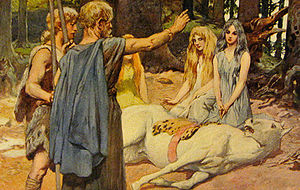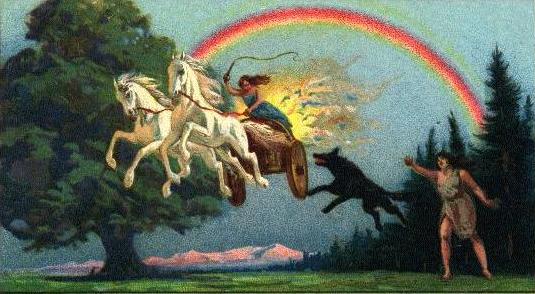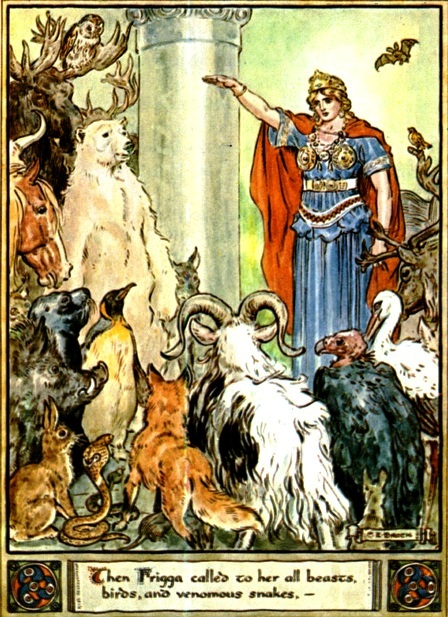Occur in the Mythic Cycle?
An Investigation
by Carla O’Harris
with help from Siegfried Goodfellow
 |
|
Is it possible to place the second Merseburg Charm within the context of the sequence of events in the mythic saga? Yes, roughly. There are a few clues. To begin with, we can assume that Frigga has not yet collected oaths from all creatures, because neither Baldur’s horse nor the iron in the horse’s shoes could turn against Baldur if such oaths had been taken, which we know were binding not only on all beasts but even on iron, and even venoms. After that oath, the recourse of any sorcerors with ill intent towards Baldur were severely circumscribed, and in fact confined to the one plant which had been overlooked, the mistletoe. But up to that point, things were fairly well game. We know that Baldur was associated with the sun-train, and a late heroic echo (Helgi Hiorvardsson) has him confronting a troll-daughter of Hati, the wolf who pursues the sun. Indeed, the order of the charm strongly suggests the order of the train itself. Obviously Baldur, who has himself been injured in the fall, cannot help his horse, and so he is successively attended to by the galdurs of Sihntgunt (Nanna, and it would naturally fall to his wife to so assist), then Sunna, the daughter of Sol, then Frigga, Baldur’s mother and Mother Earth, and then her attendant, who would naturally follow her, Fulla, and finally Odin.
Each successively tries and fails to charm the broken bone, until Odin finds the power to do so. As has been observed, the fact that all of these powerful goddesses, each gifted with tremendous healing powers, are unable to perform what should have amounted to a simple bonesetting task, is proof there was some kind of powerful sorcery at hand, a level so terrible that only Odin’s majesty and skill could overcome it. Baldur, therefore, is already under attack. This suggests he was already experiencing those ballir draumar, “dreams of misfortune”, in which heillir í svefni horfnar sýndust, “all his dream-luck seemed to vanish” that we read of in Baldurs draumar. The poet of Baldurs draumar gives us a clue as to whom the Gods suspected in this, when he says that they questioned whether this might portend grief or sorrow, but expresses this in the poem as angrs vita, where vita, generally “to know”, is being used in its inflected sense of to foreknow or bode, which if we replaced, we would find angrs boda, or Angrboda. The poet suggests the Gods either suspected this or he is giving us a hint if they don’t know. Such an opponent would indeed constitute powerful sorcery.
We thus already know that the Merseburg Charm takes place sometime between Baldur’s oppressive dreams and when Frigg has called all creatures to take oaths to safeguard Baldur. As to whether the first council indicated in Baldurs draumar has been called, is uncertain. But whether it has been officially called or not, there is definitely concern. This is indicated in the Merseburg Charm by the fact that we find Frigga in the sun-train, where we would ordinarily not expect her, which suggests she was taking up the position out of particular concern for her son. (We will see as we trace the timeline here another possible reason for her out-of-place station here.) The order of the charm gives us the relative positions in the train. Baldur must take up the frontguard, followed by Nanna, Sunna, in this instance then Frigga and her attendant Fulla, and finally, in the rearguard, Odin. Odin as well is out of place in this sun-train. Conspicuously absent from this cavalcade is Baldur’s beloved brother Hodur, who we would expect to be here. A trained warrior and fighter of monsters, he would be expected to provide protection against the wolf Hati who pursues the sun and her train. His absence suggests something was amiss, and a possible alienation from his brother. The fact that Odin takes up the rearguard indicates that this may have been Hodur’s ordinary position, which in his absence, Odin had to fill.
The absence of Hodur, and what this may portend in terms of some kind of falling-out between the brothers, allows us to place the timing of the Merseburg Charm mythologically quite specifically, because Saxo lets us know there was a time in the myths when the two brothers had fallen out, and this involved two events, a quarrel over a woman, Nanna, the daughter of the Moon God, and Hodur’s coming under the influence of a triple supernatural figure in the forest. Sorla Thattr more specifically lets us know that Hodur, there named Hedin, meets a Valkyrie-like woman in the woods who gives him a drink that makes him forget his brotherly bonds. In Helgi Hiorvardsson, we find Hedin as well, who meets a troll-woman riding a wolf in the woods, who curses him with unnatural lust for the paramour of his best friend. Saxo’s telling allows us to place this more precisely, as it interpolates some of the story of Otherus for Hotherus, and thus we find Svipdag-Odr’s quest for the gambantein sword described here, which, retrieved, the Gods feel tremendous danger for Baldur, and all assemble to protect him, at which time the shaft of Thor’s Mjollnir is lopped off by the gambantein in the hands of Odr. We know that this part of Odr’s saga took place in that general time period in the myths we may call the “Frost War”, and Saxo situates it right in the midst of a tremendous feud between Baldur and Hodur, which must have caused great consternation to the Gods. In Saxo’s description, their strife caused Hodur such anguish he left the company of men, and went wandering off into far places. The composite picture of all these tellings lets us know it was while wandering in the woods he made his ill-fated meeting with the sorcerous troll-woman, who makes for him to drink a fateful potion. It must be noted that the strife that results from this potion well precedes the death of Baldur. By necessity, it must also precede Frigga’s taking of the oaths, because she took them from all beings and spirits, and certainly Hodur counted as such a being. This means by the time she took the oaths, Hodur must have been brought back into frith with Baldur.
This explains Hodur’s absence, and the situating in the Frost War lets us know that Odin and Frigg are present not just out of concern for Baldur, which would be enough, but in a time of severe inclement weather threatening the survival of the Earth itself, the safety and security of the sun-train would be at an all-time premium. Moreover, during this period, Frigg’s children Frey and Freya have been abducted to who knows where, and so her joining a train which runs across the sky and accompanies the most powerful light beacon in the world (the sun) could give her a chance to spy out where her twin son and daughter might be. Saxo cinches the deal by letting us know that around the time that Baldur began to have oppressive dreams, he suffered an injury which made it difficult for him to walk. The Merseburg Charm explains what happened: his horse faltered, and Baldur was thrown from the horse. Chapter 101 of Burnt Njal’s saga contains an allusion to this event. It has a figure known as Hedin practice sorcery to assail a holy man, who, as he “was riding from the east, the earth split open under his horse; he leaped off the horse and managed to climb up to the rim of the chasm”. Here we have a figure riding “from the east”, as Baldur in the frontguard of the sun-train would every day, from east to west, and we have a chasm opening up beneath his horse, causing the horse to fall, with the holy man being thrown from the horse and barely managing to climb up the rim of the abyss. This describes our Merseberg situation. All of this frames the direction indicated at the beginning of the charm, where Odin and Baldur were said to be “faring” to the holza, the holt or woods. In the mythology of the sun-train, a composite picture from several different sources has been compiled which shows that at sunset they head to a place variously called Billing’s gate or the Varns, which is considered a kind of protective forest. Here Billing’s warriors raise their torches and set bonfires to celebrate the sun’s successful journey each day. This mirrors the ritual practices of holiday bonfires documented by Grimm and Frazer, particularly the Midsummer fires, which in Scandinavia were called Baldurs balar, “Balder’s fires”. These bonfires were set for auspicious purposes, and in Sweden especially to drive off witches, and farm animals were often passed through the flame or fanned with the smoke to bless them. Most pertinent, however, is the recurring theme of these fires needing to be set by two brothers or twins, which points us back to the twins of Baldur and Hodr. All of this suggests a connection between the mythic zone of the Varns, where the sun-train rested, and the holiday fires, either as if the latter were reenacting the mythic site, or as if the former were practicing a holiday ritual, or both. Also relevant is that it was considered lucky to leap over the bonfire. Given that leaping was associated with the bonfires, and that animals were passed through, this suggests that the mythic picture in the Merseburg Charm was one where Baldur’s horse faltered right at this point in the journey, in the Varna vidr, possibly in the process of leaping over the lucky frame. Yet what was intended as luck in that moment of faltering turned darkly to great inauspiciousness. Suddenly woods that were designed as protection proved not as protective. There is a second possibility we must consider here, however, in the construal of these events. The fact that Odin and Baldur were going to a “holt” suggests this alternative. Very often in the mythic literature, a “holt” specifically refers to the Grove of Mimir, Odin’s uncle and keeper of the Well of Wisdom, with whom Odin particularly consults in times of grave difficulties. The presence of all of Baldur’s immediately family (sans Hodur) underlines this situation of grave difficulty, and suggests as well that this may have been the original gathering or council indicated at the beginning of Baldurs draumar. They may all have been traveling in council to ask of Mimir what to do about Baldur’s oppressive dreams. The poem indicates they were all asking questions, but the verb, spurdu, is more like an official inquest or inquiry. Mimir as the ultimate source of wisdom would be the go-to man from whom to seek answers. If the Merseburg Charm describes to us this voyage to Mimir, the disaster that results in Baldur’s horse getting lamed, and Baldur suffering a foot injury in the process would be considered extraordinarily inauspicious. This could explain why shortly after meeting in council and apparently coming up with a solution that seemed that it could work, Odin uggir, van sé tekit, “was terrified that some weakness had befallen”, and that hamingjur ætlar horfnar mundu, “the hamingja of the clan may have completely vanished”. Obviously, a van or weakness had befallen, as Baldur is described by Saxo as too weak to walk, and through an allusion connected to Olaf Geirstaadalf, we know it was specifically a foot-injury. Every journey is auspicious, and if this one began in such a terrible way, particularly on the way to see Mimir, this would explain why Odin became uggir, “terrified”, which in turn explains why a second council of the Gods has to be called, at which time it is decided to send Odin on his own into the underworld to see what information he can find. We know precisely who Odin suspected, and he would seem in this journey to bypass Mimir altogether and go straight to the source: Gullveig. But that this takes place some time after these events is suggested by the fact that it is after it has been decided to take oaths from all beings.
If Baldur was going to consult with Mimir – and here, given the
general time frame I have elaborated above, we may see all of
this concerning much more than Baldur, but the entire weather
pattern and fate of the earth, with the God most connected to
the sun oppressed with terrible dreams, and the weather changing
– then where was Hodur, according to this construction?
Interestingly, Saxo describes Hodur as meeting three maidens in
the woodland, whom he would seem to treat as if they were norns.
Was Baldur sent to consult with Mimir, while Hodur was sent to
consult with the Norns? As we know, Hodur had not actually met
the Norns but from the composite picture, Gullveig, who we know
has three infamous incarnations, which Saxo may have glossed as
three simultaneous beings rather than successive identities.
However, the story may be relatively intact in his telling,
which suggests Hodur was expecting some sort of meeting with the
Norns. Hodur’s failure to actually make contact with Urd (as
well as the derangement that resulted from his encounter with
Heid and the ale that brought on his forgetfulness of his frith
with his brother) would then explain why in Forspjallsljod
Bragi, Heimdall, and Loki had to make the trip to visit Urd. By
this time, mythically, Mimir would have been occupied, with his
dwarf-retinue, in retrieving the gambanteinn from Volund in the
Wolfdales, which could be another reason subsequent to the first
attempt, Odin didn’t visit him. The severity of these events is important to the working of the charm. The Anglo-Saxon poem Deor may actually function as a charm. It describes several mythic calamities, and after each one, observes, Þæs ofereode, þisses swa mæg, “that passed over, so may this.” The same spirit, without the same refrain, governs the Merseburg Charm, for no mere mortal’s horse sprains can compare to the calamity of Baldur’s horse being thrown, but if Odin was able to heal a disaster of that scale with this charm, the recipient may rest assured his much more mundane situation may also be healed. And as it involves the sun-train, the recipient may also look up in the sky and see that the sun still shines, and knowing the mythic story of a time when the sun was hidden by clouds for extended winters, even if the sun is blocked in the midst of winter, the believer would know that the Spring would once again return, promising happy possibilities for all. |
|||||||||||||||||
— Carla O'Harris |
|||||||||||||||||
 Hodur, Shoe-smith; Baldur, Foot-Lamed An Investigation |
|||||||||||||||||




